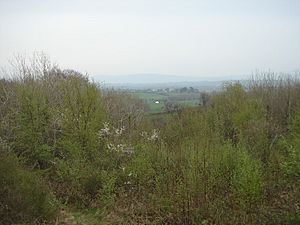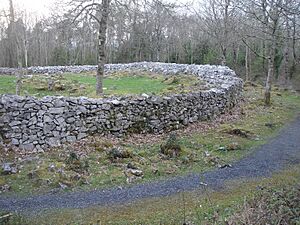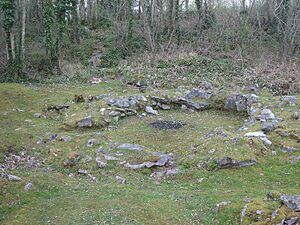Mooghaun facts for kids
Quick facts for kids
Mooghaun
Múchán
|
|
|---|---|
|
Hillfort
|
|
 |
|
| Country | Ireland |
| Province | Munster |
| County | County Clare |
| Elevation | 70 m (230 ft) |
| Irish Grid Reference | R408705 |
Mooghaun (pronounced Moo-hawn, from the Irish Múchán) is a very old hill fort from the late Bronze Age. It's found in County Clare, Ireland. This amazing site is really well-preserved and sits on top of a whole hill. From here, you can see far across the land. Many people think Mooghaun is the biggest hill fort in all of Ireland, making it a popular place to visit.
Exploring Mooghaun Hill Fort
Mooghaun is located in a place called Mooghaun South. It's about 3 kilometers (2 miles) north-east of Newmarket on Fergus. You can find it on the large grounds of Dromoland Castle.
Defensive Walls and Structures
The hill fort has three huge circular walls built for defense. These walls are made of limestone and were all built at the same time. They are called ramparts.
- The outer wall covers a huge area, about 27 acres (11 hectares).
- The middle wall encloses about 7.4 acres (3 hectares).
- The innermost wall is the smallest, covering about 2 acres (0.8 hectares).
The fort sits on top of a hill. From here, the people who lived there could see the land they controlled. Today, many trees block the view. There are also some older stone forts called cashels on the grounds. These were built much later.
A Look Back in Time: Mooghaun's History
The Mooghaun hill fort was built a long, long time ago. This was at the start of the late Bronze Age, around 950 BC. Back then, Mooghaun was the biggest and most important place in the whole area.
Life at the Hill Fort
Later, after 500 AD, three cashels were built inside the fort. The builders used stones from the original ramparts to make these new walls. Archeologists also found the outlines of round houses. These show where people used to live.
Perhaps 10 to 12 families lived within the hill fort's walls. These families likely farmed the land inside the fort. They also kept their animals there. Most of them lived in the middle part of the fort.
Leaders and Their Territory
The people who planned and built Mooghaun were leaders of a large area. This area was called a "chiefdom." It covered about 450 square kilometers (174 square miles) in south-east Clare.
This chiefdom was bordered by the Shannon estuary to the south. Mountains were to the north, east, and west. The land was divided into smaller areas, each about 25 square kilometers (10 square miles). Important families controlled these smaller areas. They lived in smaller forts on hilltops or in settlements near lakes. Less important families lived in villages with low stone walls. These villages often appeared in groups. Each group farmed a large area of land.
Later Uses of the Site
Much later, in the late 1700s or early 1800s, people from the nearby Dromoland estate used the cashels. They might have used them as a place to enjoy the view or even for picnics. To make it easier, they changed much of the inside of the fort. They also repaired some of the old walls.
The Mooghaun North Gold Hoard
A very special discovery was made near Mooghaun in 1854. It was a huge collection of gold jewelry from the Late Bronze Age. This amazing find happened during the building of a railway line from Limerick to Ennis.
What Was Found?
The collection, called a "hoard," likely had hundreds of gold objects. Sadly, most of them were sold to jewelers and melted down. But many copies were made. Today, only 29 original pieces still exist. They are kept in the National Museum of Ireland and the British Museum.
Most of the objects were simple gold hoops. They came in different sizes. There were many bracelets, some large neck rings called torcs, and wide gold collars. Some gold bars, called ingots, were also found.
Why Was It There?
The gold hoard was found near Mooghaun Lough (a lake). Experts believe it was placed there as a special offering or "ritual deposit." This gold would have been worth a huge amount of money back in the Bronze Age!




